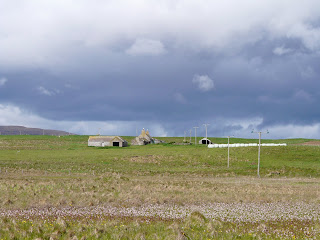While Anne is putting the final touches to the latest Links plate, I've been plugging away at the text for some of the freshwater plants. This particular section is actually called 'Lochs, burns, freshwater marshes and wet grasslands' . It's a wide field and I've finally narrowed it down to 6 plates taking in 33 species.
It's always good to be writing about something that's immediately relevant and at present many still waters are clothed with spectacular coverings of Bogbean or, I suppose, Bogbeans. I've included a couple of photos of Bogbean on Egilsay where it can be found in many of those superb wetlands that the island is justifiably important for. I've uploaded also, as a sneak preview, the full draft text from our 'waiting in the wings' book.
Bogbean (Menyanthes trifoliata) Crawshoe
Bogbean family
Height to 30cm; flowers June to July. Widespread and frequent in Orkney (18/28) and in Britain
Few plants can have had such significance to such a wide range of peoples in the northern hemisphere as Bogbean. As a food, the roots were ground into flour by Laplanders and native Americans in Alaska Scotland made into tobacco. As a medicine, it was esteemed as a cure-all and used to treat digestive ailments, headaches, migraine, ague and rheumatism. Known as Gulsa girse in Shetland it treated jaundice and in Germany England and Scotland
Bogbean grows in bogs, swamps and fens and in the shallow waters at the edge of lochs. With its ability to trap sediments, it can be responsible for drying out areas of open water. In his Herbal, Gerard described this ‘beauty of the black moorland waters’ as follows: “toward the tip of the stalk standeth a bush of feather-like flowers of a white colour dasht with a wash of light carnation”. The flowers have five lobes, star-shaped and fringed with stiff white hairs. The long-stalked, grey-green, oval leaves are in threes and stand proud out of the water.
towards Grugar, Egilsay




No comments:
Post a Comment